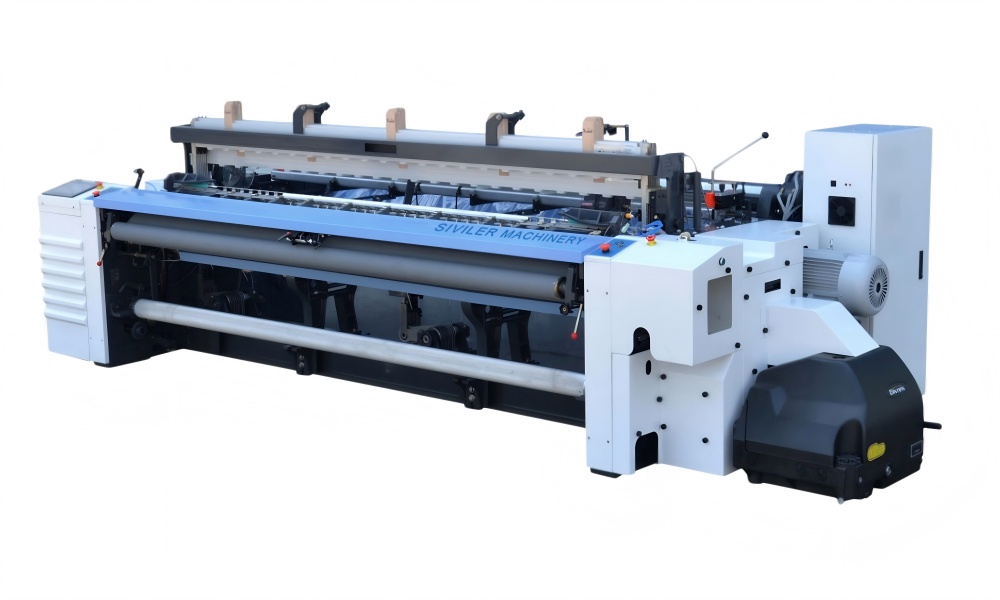The Water Jet Loom stands at the forefront of modern textile manufacturing technology. Combining high efficiency, superior fabric quality, and sustainable design, this weaving machine has transformed the way fabrics are produced across the globe. This article explores the key advantages and distinctive features of the Water Jet Loom, demonstrating why it is the preferred choice for many textile producers. Additionally, a comparative analysis with other weaving technologies such as air jet looms and shuttle looms will further illustrate its competitive edge.
1. High-Speed Production Capability of Water Jet Looms
One of the most significant advantages of the Water Jet Loom is its high-speed weaving ability. By utilizing a powerful jet of water to insert the weft yarn through the warp yarns, water jet looms dramatically increase production speed compared to traditional weaving methods.
Mechanism Behind High Speed
Unlike shuttle looms, which mechanically shuttle the weft yarn back and forth, the water jet loom propels the yarn using a jet of water at high velocity. This method minimizes mechanical movement and inertia, allowing for faster insertion cycles. This results in a remarkable increase in weaving speed, with modern water jet looms capable of reaching speeds of over 1,000 picks per minute.
Impact on Production Efficiency
- Higher Output: The accelerated weaving speed directly translates into greater fabric production per unit time, meeting the demands of high-volume textile manufacturing.
- Reduced Downtime: With fewer mechanical parts subject to wear and tear, water jet looms experience less frequent breakdowns, ensuring continuous operation.
- Cost-Effectiveness: Faster weaving reduces labor and energy costs per unit fabric, enhancing overall profitability for manufacturers.
Ideal for Specific Fabric Types
While the water jet loom excels in speed, it is particularly suited for synthetic yarns like polyester and nylon, which withstand water jet pressure well, enabling consistent and uninterrupted high-speed operation.
2. Energy Efficiency and Eco-Friendly Design
In today’s manufacturing environment, energy consumption and environmental impact are critical considerations. The Water Jet Loom excels in both areas through its innovative and eco-conscious design.
Energy Efficiency
- Water as Propulsion Medium: Using water instead of compressed air or heavy mechanical components significantly reduces energy consumption. Pumps powering the water jets consume less electricity than compressors used in air jet looms.
- Lower Mechanical Friction: With fewer moving parts involved in weft insertion, mechanical energy loss is minimized.
- Advanced Pump Technology: Modern water jet looms employ energy-efficient water pumps optimized for consistent high pressure with minimal power use.
-
Environmental Sustainability
- Water Recycling Systems: Contemporary water jet looms incorporate filtration and recycling technology that cleans and reuses water during operation, drastically reducing water wastage.
- Reduced Noise and Vibration: Compared to shuttle looms, water jet looms generate less mechanical noise and vibration, improving the workplace environment.
- Lower Emissions: Energy-efficient operation translates to a smaller carbon footprint, aligning with global green manufacturing initiatives.
Benefits for Manufacturers
Adopting Water Jet Looms allows textile companies to not only reduce operating costs but also meet increasingly stringent environmental regulations, making their production more sustainable and socially responsible.
3. Enhanced Fabric Quality with Water Jet Looms
Fabric quality is paramount in textile manufacturing, influencing product durability, appearance, and feel. The Water Jet Loom contributes to superior fabric quality through precise and gentle yarn handling.
Gentle Yarn Handling
The water jet insertion method reduces mechanical stress on the weft yarn compared to shuttle looms where physical shuttles can snag or break threads.
This is especially beneficial for delicate or high-performance synthetic fibers, which can be damaged by excessive friction or tension.
Uniform Fabric Density
The controlled speed and consistent weft insertion improve fabric uniformity.
Water jet looms allow precise tension control over the yarns, resulting in a tightly woven fabric with consistent appearance and strength.
Versatility in Fabric Types
Water jet looms excel at producing lightweight to medium-weight fabrics used in apparel, home textiles, and technical textiles.
The ability to weave hydrophobic synthetic fibers without damage expands possibilities for innovative fabric blends and functional textiles.
Quality Benefits for End Products
Fabrics woven on water jet looms typically exhibit fewer defects, higher tensile strength, and a smoother surface finish, all of which enhance the final product’s market competitiveness.
4. Ease of Operation and Advanced Automation
The evolution of Water Jet Looms includes significant improvements in user-friendliness and automation, reducing the need for constant manual oversight.
Intuitive Control Systems
Modern water jet looms are equipped with PLC (Programmable Logic Controller) systems and touchscreen interfaces.
Operators can easily monitor machine status, adjust parameters, and respond to alerts in real-time.
Automated Functions
- Warp and Weft Monitoring: Sensors detect yarn breakages instantly, pausing the machine to avoid defects.
- Water Pressure Regulation: Automated systems maintain optimal water jet pressure for consistent weaving quality.
- Fault Diagnosis: Integrated diagnostics identify potential issues early, minimizing downtime.
Reduced Labor Intensity
Automation reduces the need for highly skilled operators and frequent manual intervention.
Operators can manage multiple machines simultaneously, improving labor efficiency.
Maintenance Simplicity
Water jet looms require less mechanical maintenance compared to shuttle looms, thanks to fewer moving parts.
Self-cleaning water filters and automated water management systems further ease upkeep.
5. Comparison with Other Loom Types: Air Jet Loom and Shuttle Loom
To fully appreciate the advantages of Water Jet Looms, it is important to compare them with other common weaving machines: air jet looms and shuttle looms.
5.1 Water Jet Loom vs. Air Jet Loom
Summary
Water jet looms are more energy-efficient and environmentally friendly but are mostly limited to synthetic fibers due to water contact. Air jet looms, while versatile, consume more energy and have higher operational costs.
5.2 Water Jet Loom vs. Shuttle Loom
Summary
Compared to shuttle looms, water jet looms offer faster production, quieter operation, and better fabric quality for synthetics. However, shuttle looms remain useful for wide-width fabrics and heavier materials.
6.Conclusion
The Water Jet Loom delivers exceptional benefits in high-speed textile production, energy efficiency, excellent fabric quality, and user-friendly operation. Its environmentally friendly design and advanced automation align perfectly with today’s focus on sustainable manufacturing. While it is best suited for synthetic fibers, the advantages it offers make it a valuable asset for modern textile producers.
When compared to air jet and shuttle looms, the Water Jet Loom provides an optimal balance of speed, cost-effectiveness, and quality, making it a smart investment for manufacturers specializing in synthetic fabrics


